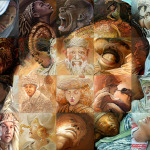by Fr. Patrick Henry Reardon
 Essential to the idea of the Incarnation is what Anscar Vonier called
Essential to the idea of the Incarnation is what Anscar Vonier called
“the assumption that to God mankind is a unity far beyond anything we can conceive.”
I will argue, in these reflections, that this unity is biological, psychological, and historical.
With respect to biology, perhaps some attention should be given to a recent theory that interprets the biblical Adam as a literary metaphor for the human race or for some early portion thereof.
Aside from the shock and dismay it would animate in the minds of St. Irenaeus and others, is it not obvious that such an interpretation reflects a failure to understand Genesis through a Christological lens? In the New Testament Christ’s solidarity with the humanity is inseparable from his descent from the common father of us all.
I hope it is clear that I have more in mind than simply Adam’s name. The ubiquitous appearance of ’adam in the Hebrew Bible—562 times and in every major source and era—is convincing evidence of the Old Testament’s abiding interest in the entire human race, and not simply the Jews.
“Adam” is the noun normally used in the Hebrew Bible to mean “mankind” or “the human race.” In the instances where ‘adam refers to individuals, those individuals tend to be representative of humanity as such. Thus, we are told,
“Blessed is the ‘adam to whom the Lord imputes no guilt” (Psalms 32 [31]:2).
Because it has this generic nuance, ‘adam is never pluralized in Hebrew. For the same reason it is never used in what grammarians call “construct”; this means that the noun is never modified by a genitive. For example, if the Bible wants to describe someone as a “man of mercy,” some other noun for “man” must be employed. ’Adam has too general a sense to be used in such a case.
In no way, however, does this general sense of “Adam” warrant the notion that there was no uniquely original person who goes by that name in the opening chapters of Genesis. If humanity had no initial father, then there is no common human history and, thus, no structural nucleus for the salvific event known as Jesus Christ. The Fall declared in Genesis was a single, factual, incident. In some way, then, hamartiology is inseparable from biological history.
With respect to this point, we observe an obvious and important distinction Genesis makes: Whereas all other creatures on the earth are created in the plural, the origin of the human race is located in a single couple (Genesis 1), even a single individual (Genesis 2). God did not create men; He created a Man.
If the Christian faith, the deposit once transmitted to the saints, is to remain intact, the historicity of the first parent—call him “Ralph” for all I care—is as essential as the historicity of Jesus. If the whole human race—indeed, the entire universe, of which man is the head—did not fall in the one man, Adam, then it could not possibly have been redeemed in the one man, Jesus Christ.
Among those who imagine the biblical Adam to be metaphorical, the early chapters of Genesis are commonly treated as a form of mythos. Indeed, this may be the source of the problem, because the category of mythos provides a seriously inadequate format for understanding this part of Genesis.
The author of Genesis—for the heck of it, let’s call him “Moses”—in constructing the story of Creation, is not looking at it from outside. He is not taking the “matter” around him and subjecting it to an arbitrary narrative, an account alien to its essence. Rather, Moses is actively striving to examine what the Greeks would later call a mneme, a memory. What he endeavors to accomplish, as he crafts the story, is not mythos but anamenesis.
It would be impossible for Moses to do this without the priority of an icon. (The “what” of memory is always an icon.) Here is what we have in Genesis: Moses, his mind elevated by the prophetic Spirit, reverts to that inner native image derived from our first parent, the primeval tselem ’Elohim by virtue of which man is the “head” (the thinking part) of Creation.
Moses gazes at the world (and history) through the mediating light of this icon, indistinguishable from his own being. He regards Creation from within its intelligible structure, inasmuch as he is the sole locus of the world’s understanding and self-reflection.
What he writes he writes in rei memoriam.
This is remembered history, not myth.
See also: Was Adam an Actual or Symbolic Figure, According to the Fathers of the Church?
